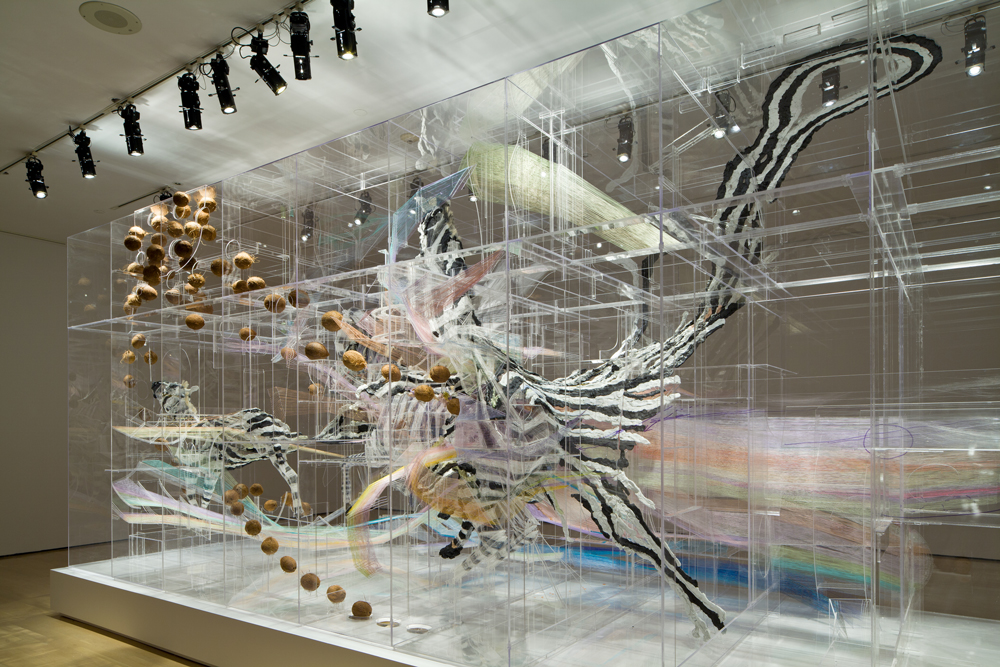When it opens on June 20 at the Musée d’art contemporain de Montréal, the solo exhibition “Flux” will represent a major homecoming for David Altmejd, a prodigal son of this fair city. The show has already wowed audiences in Paris, at the Musée d’art moderne, and in Luxembourg, at the MUDAM—but for an artist so inspired by the concept of cycles, the final Montreal stop has got to be the most significant. We caught up with him for a bit of a preview.
Isa Tousignant: Can you paint a picture of what we can expect out of “Flux”?
David Altmejd: The exhibition will be divided into periods, but to say it’s chronological would be reductive. I want each room to emanate a completely different atmosphere. The first work that’ll open the exhibition is a portrait of my sister, Sarah Altmejd. I see it as nothingness. It’s a bust of my sister, whom I adore, with a black hole in lieu of a face. It’s like the universe just a fraction of a second before the Big Bang. It’s just space.
Then the first room will be plunged in darkness, to correspond with the beginning of my work as a sculptor, with works that are very architectural and developed on a horizontal plane. I like the idea of starting in darkness, where things look like they’re floating and aren’t quite formed. In the second room, everything is presented on the vertical plane; there are giants, it’s much more grandiose, classical, monumental and it basks in light. After that, it’ll be something different. There’ll be five or six distinct spaces.
IT: Are you saying that you spent the early years of your career in the dark?
DA: I didn’t feel it at the time, but, in hindsight, it makes sense that way.
IT: What’s behind the title, “Flux”?
DA: “Flux” is a word that’s part of the exhibition’s main piece, titled The Flux and the Puddle. It’s the most important piece because it’s the last piece I did, and it’s also a sort of synthesis. It’s a monumental work that contains everything I’ve done in sculpture since the beginning of my career. All the materials, all the references. It became like a studio in itself; the entire sculpture is built inside a giant Plexiglas box that took over practically my entire studio space. When I wanted to create objects to insert in it, I had to build them actually inside the box.
That’s something that’s always interested me: the idea that an object retains the memory of its fabrication. An object contains all the energy that went into making it. It’s part of what interests me so much about the human body. What makes the body so particularly incredible is that it’s able to produce energy, to transform, to grow. It’s something I always try to instil in the sculptures I make, that idea of energy. I’m an energy fetishist.
IT: The body also retains all the traces of time, which is something you also do in your works: you map their making, even in such a direct way as to include threads that illustrate your passage through them.
DA: Yes, the body is also an accumulation of moments, a record of its history. That’s why, when accidents happen while I’m working on a sculpture—like if a piece of Plexiglas breaks or something—I don’t see it as a bad thing, I see it as an opportunity to rebuild, to create a bandage, if you will. It’s a chance to give more history to the object. The object exists by breaking, by rebuilding, by becoming more solid, by breaking again—and therefore it has its own history.
IT: You work with both the macro and micro in this exhibition. Do you see them as opposites?
DA: I love to to-and-fro between the micro and the macro. I like thinking about the infinite, and I like thinking about the possibilities of the infinitely big, and also the infinitely small and zoomed in, which, in fact, are the same thing. The interior and the exterior are the same thing. What’s inside our minds and it out there in the universe is exactly the same thing. I also like the change of scale in my own working process.
In the studio I like working on something really big and then, the next day, concentrating on a teeny, tiny detail for an entire day. I like my works to involve a complex production process, a bit like a film. I feel that the complexity of the working process gives a complexity to the work, just like I believe the energy of the production translates into the energy of the piece. I want my work to give the impression of containing the intelligence that went into its creation.
IT: Is this exhibition something of a summary, before moving on to a next chapter?
DA: Yes. I wouldn’t say the entire exhibition closes a chapter, but certainly The Flux and the Puddle does. Just as The Index did, when I showed at the Venice Biennale. It’s as if every seven years I feel I need to synthesize what I’ve been doing to move on to the next thing.
IT: So, what’s next?
I’m really interested by the idea of reversal. There are a few pieces in this exhibition, which I created while I was making The Flux and the Puddle, which are upside-down. I feel like I’m discovering a whole new space. I began a series of heads a while back, whereby I work on a head, give it an identity and a soul, and then I flip it and use the eyes as the starting point for a new face, a new head, a new identity while forgetting the old one. It creates an object that contains two identities, one much more direct, and the other hidden, forgotten, old, but still there. That interests me enormously.









